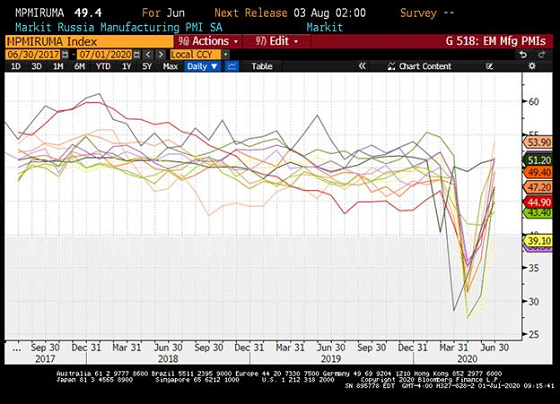By Natalia Gurushina, Chief Economist, Emerging Markets Fixed Income Strategy, VanEck Global
EM activity gauges improved in June, and the external environment looks more supportive. Mexico’s overseas remittances continue to exceed expectations—a positive for domestic consumption.
Emerging markets’ (EM) June activity gauges looked more upbeat. There were multiple upside surprises—led by China’s Caixin manufacturing PMI (Purchasing Managers Index) with the EM “PMI curve” increasingly looking like “V” (see chart below). Today’s data releases in key developed markets (DM) suggest that the global backdrop might be getting more supportive as well. These are all positives. The devil (as usual) is in detail. First, there is a lot of divergence. EM Asia—on average—looks the least bad, with the largest number of countries in expansion zone. All Central European countries are currently in the bottom half of our EM sample. Second, two-thirds of PMIs are still in contraction zone, which means that we are talking about a slower pace of deterioration rather than a fully-fledged recovery. And this means more policy support from EM governments and central banks.
Is Mexico’s remittances risk exaggerated? Today’s larger than expected print for May (USD3.4B) surely points in this direction. The number was above the seasonal range for the past five years and can no longer be explained by COVID-related pre-emptive transfers. This is infinitely better than the World Bank’s early-COVID estimates, and should help to support domestic consumption in the coming months.
Argentina’s debt negotiation brinkmanship was on full display yesterday following the release of a joint statement from two groups of bondholders blasting the government for the lack of “serious engagement”. This is not unusual, and we would like to stress that there is still a lot of time left until the next (final?) deadline. In the meantime, the unexpected reversal of Argentina’s current account balance—a USD444M deficit in Q1 2020 instead of a projected small surplus—is yet another reminder that the macroeconomic environment remains extremely fragile, and that a real exchange rate appreciation (due to high inflation) can have a sizable impact on hard currency flows.
Chart at a Glance: EM Recovery – “V” with a Twist

Source: Bloomberg LP
IMPORTANT DEFINITIONS & DISCLOSURES
PMI – Purchasing Managers’ Index: economic indicators derived from monthly surveys of private sector companies; ISM – Institute for Supply Management PMI: ISM releases an index based on more than 400 purchasing and supply managers surveys; both in the manufacturing and non-manufacturing industries; CPI – Consumer Price Index: an index of the variation in prices paid by typical consumers for retail goods and other items; PPI – Producer Price Index: a family of indexes that measures the average change in selling prices received by domestic producers of goods and services over time; PCE inflation – Personal Consumption Expenditures Price Index: one measure of U.S. inflation, tracking the change in prices of goods and services purchased by consumers throughout the economy; MSCI – Morgan Stanley Capital International: an American provider of equity, fixed income, hedge fund stock market indexes, and equity portfolio analysis tools; VIX – CBOE Volatility Index: an index created by the Chicago Board Options Exchange (CBOE), which shows the market’s expectation of 30-day volatility. It is constructed using the implied volatilities on S&P 500 index options.; GBI-EM – JP Morgan’s Government Bond Index – Emerging Markets: comprehensive emerging market debt benchmarks that track local currency bonds issued by Emerging market governments.; EMBI – JP Morgan’s Emerging Market Bond Index: JP Morgan’s index of dollar-denominated sovereign bonds issued by a selection of emerging market countries; EMBIG – JP Morgan’s Emerging Market Bond Index Global: tracks total returns for traded external debt instruments in emerging markets.
The information presented does not involve the rendering of personalized investment, financial, legal, or tax advice. This is not an offer to buy or sell, or a solicitation of any offer to buy or sell any of the securities mentioned herein. Certain statements contained herein may constitute projections, forecasts and other forward looking statements, which do not reflect actual results. Certain information may be provided by third-party sources and, although believed to be reliable, it has not been independently verified and its accuracy or completeness cannot be guaranteed. Any opinions, projections, forecasts, and forward-looking statements presented herein are valid as the date of this communication and are subject to change.
Investing in international markets carries risks such as currency fluctuation, regulatory risks, economic and political instability. Emerging markets involve heightened risks related to the same factors as well as increased volatility, lower trading volume, and less liquidity. Emerging markets can have greater custodial and operational risks, and less developed legal and accounting systems than developed markets.
All investing is subject to risk, including the possible loss of the money you invest. As with any investment strategy, there is no guarantee that investment objectives will be met and investors may lose money. Diversification does not ensure a profit or protect against a loss in a declining market. Past performance is no guarantee of future performance.







